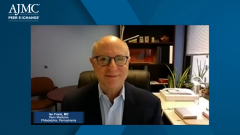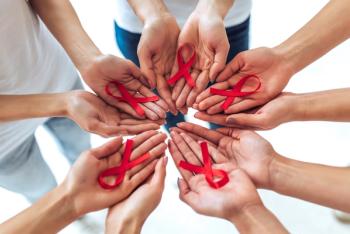
CDC PrEP Care System Process and Assessing Risk of HIV
Ian Frank, MD and Jeffrey Crowley, MPH describe the CDC PrEP Care System Process and eligibility criteria for receiving PrEP.
Episodes in this series

Neil Minkoff, MD: I think we’re already hitting one of the important issues, which is it’s the right thing to do, and trying to do the right thing for public health versus cost effectiveness, and how to measure that. I’m sure that’s something people struggle with somewhat when you’re trying to make the business case, which many of us have to do, to employers for coverage, or public payers for coverage, and so on, which leads me to the CDC [Centers for Disease Control and Prevention]’s PrEP [pre-exposure prophylaxis] Care System process. One of the things we do as a society is we say, let the CDC weigh in on these things and be an arbiter. I’ll open it up widely in terms of how people feel. Dr. Frank, I’ll get you to start around the CDC process, and if you could explain it to our audience a bit and what it means.
Ian Frank, MD: I don’t think the CDC is thinking about PrEP from a cost-effectiveness perspective. They’re thinking about it from a public health perspective. The CDC goal is to eliminate new cases of HIV infection, and there’s basically 3 ways to do that. Expand testing so that we identify everybody who’s HIV infected, link those individuals to care, and start those individuals on antiretroviral therapy to get their viral load undetectable. If we can achieve that, those individuals with an undetectable viral load do not transmit their infection to their partners. Those are actually the first 2 components; testing, treatment, and then for individuals who continue to engage in behavior that may put them at risk for HIV acquisition, give them PrEP to prevent them from becoming infected. The CDC estimates are conservative. If 40% of the over 1 million individuals who the CDC estimates would benefit from and who qualify for PrEP, if 40% of them were on PrEP, and the adherence was a modest 62%, we could prevent one-third of new cases of HIV infection. I don’t know what kind of cost savings that would mean, but that would have a huge impact on onward cases of HIV transmission, and the ability to get HIV under more effective control in the United States.
Neil Minkoff, MD: Can I follow up a little on one of the things you said there in terms of people who qualify for PrEP? That was one of the phrases you used in terms of defining the population. Just for the sake of everybody involved who are going to be listening to this, how does one qualify for PrEP in that determination?
Ian Frank, MD: There are different criteria, or there are different behaviors that one would engage in that would determine whether somebody was at risk. But essentially, these are individuals who are having sex with multiple partners whose HIV status is known to be positive, or unknown, or not known to be negative. Individuals who are engaging in behavior with folks who may be HIV infected or who are known to be HIV infected, having multiple partners, not using condoms consistently. Whether you’re a man who has sex with men, or a woman who has sex with men, that would put you at risk for becoming HIV infected. If you’re somebody who injects drugs, if you share needles, or share works [injection drug equipment], that would qualify you as being somebody who would benefit from PrEP. Thus, there are sexual risk factors, and there are drug use factors. The CDC has included in their PrEP guidance an algorithm that you could use to ask an individual about various behaviors, their age, and other factors that are included in the model, and come up with a risk score. If somebody scores a certain number of points, it would be recommended that they start on PrEP. But as a PrEP provider, I take a far more simple approach. That is, if somebody is engaging in sexual practices where they’re not always using condoms, and if they’re not in a monogamous relationship with somebody who is known to be HIV uninfected, that individual would likely benefit from PrEP.
Jeffrey Crowley, MPH: I also want to add that one other thing to think about is that individuals themselves should be able to self-select for PrEP. Uptake is low; we haven’t seen people coming out of the woodwork who don’t really need to be on PrEP trying to get on it. But because some of these questions are so sensitive, they may not be willing to report that they’re having sex without a condom. However, if they themselves report to a clinician that they think they need PrEP, we should probably listen to them, and consider them good candidates.Ian Frank, MD: I totally agree with that, but I would say there’s an opposite side to that coin, and that is that many individuals underestimate their risk. For example, if somebody says, “I believe I would benefit,” I would certainly take them at their word. But if somebody says, “I don’t think I need it,” I wouldn’t just stop there. I’d asked them the questions to help them understand their risk in a bit more informative way.
Neil Minkoff, MD: Let me ask you a question about that, which is one of the things I think in multiple disease states, a lot of public health or other officials try to come up with some sort of objective scoring mechanism or a checklist in terms of qualifications. But when you’re talking about these things, it sounds like it’s much more related to the clinical gestalt of the clinician, as interacting with the patient in terms of what the patient needs and would benefit from, without necessarily an objective scoring system, if you will.
Ian Frank, MD: That’s the way I look at it. If you use the CDC scoring criteria, they say you need 10 points. If you have only 9 points, does that mean you’re not at risk? If you have 8 points, does that mean you’re not at risk? If you have 11 points, does that mean you’re at risk? It’s also important that folks understand that behavioral risk is not a steady state kind of thing. I don’t like to talk about people who are at high risk or low risk because people’s risk varies. People are sometimes doing things that are riskier than others. I do HIV prevention research, and many of the individuals who get infected in our HIV vaccine studies are folks who would say, “I’m at low risk.” They don’t have a lot of partners. They usually use condoms. But on a rare occasion, they may do something that’s very risky, and that 1 risky event may lead them to become HIV infected. Thus, I think understanding PrEP and how to use it in a way that makes the most sense for your lifestyle is critical if we’re going to implement a successful PrEP program.
Transcript edited for clarity.
Newsletter
Stay ahead of policy, cost, and value—subscribe to AJMC for expert insights at the intersection of clinical care and health economics.













































